Point-of-Care Surface Plasmon Resonance Biosensor for Stroke Biomarkers NT-proBNP and S100β Using a Functionalized Gold Chip with Specific Antibody
- PMID: 31163612
- PMCID: PMC6603756
- DOI: 10.3390/s19112533
Point-of-Care Surface Plasmon Resonance Biosensor for Stroke Biomarkers NT-proBNP and S100β Using a Functionalized Gold Chip with Specific Antibody
Abstract
Surface-plasmon-resonance (SPR) is a quantum-electromagnetic phenomenon arising from the interaction of light with free electrons at a metal-dielectric interface. At a specific angle/wavelength of light, the photon's energy is transferred to excite the oscillation of the free electrons on the surface. A change in the refractive-index (RI) may occur, which is influenced by the analyte concentration in the medium in close contact with the metal surface. SPR has been widely used for the detection of gaseous, liquid, or solid samples. In this study, a functionalized specific SPR chip was designed and used in a novel point-of-care SPR module (PhotonicSys SPR H5) for the detection of the stroke biomarkers NT-proBNP and S100β. These biomarkers have proven to be good for stroke diagnosis, with sensitivity and specificity of >85%. Specific detection was done by binding a biomolecular-recognizing antibody onto the Au SPR-chip. Detection was tested in water and plasma samples. NT-proBNP and S100β were detected in a range of concentrations for stroke, from 0.1 ng/mL to 10 ng/mL. The RI of the blank plasma samples was 1.362412, and the lowest concentration tested for both biomarkers showed a prominent shift in the RI signal (0.25 ng/mL NT-proBNP (1.364215) and S100β (1.364024)). The sensor demonstrated a clinically relevant limit-of-detection of less than ng/mL.
Keywords: Au SPR-chip; NT-proBNP; S100β; biomarkers; biosensor; diagnostics; point-of-care; refractive-index; stroke; surface-plasmon-resonance.
Conflict of interest statement
The authors declare no potential conflicts of interest with respect to the research, authorship, and/or publication of this article.
Figures
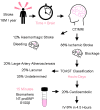
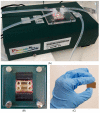

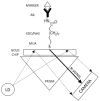


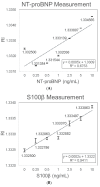
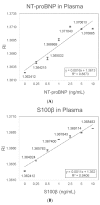
Similar articles
-
Functionalized silicon dioxide self-referenced plasmonic chip as point-of-care biosensor for stroke biomarkers NT-proBNP and S100β.Talanta. 2020 May 15;212:120792. doi: 10.1016/j.talanta.2020.120792. Epub 2020 Jan 30. Talanta. 2020. PMID: 32113554
-
Simultaneous detection method for two cardiac disease protein biomarkers on a single chip modified with mixed aptamers using surface plasmon resonance.Talanta. 2024 Jan 15;267:125232. doi: 10.1016/j.talanta.2023.125232. Epub 2023 Sep 27. Talanta. 2024. PMID: 37806108
-
A label-free ultrasensitive microfluidic surface Plasmon resonance biosensor for Aflatoxin B1 detection using nanoparticles integrated gold chip.Food Chem. 2020 Mar 1;307:125530. doi: 10.1016/j.foodchem.2019.125530. Epub 2019 Oct 1. Food Chem. 2020. PMID: 31639579
-
Ultra-sensitive detection by metal nanoparticles-mediated enhanced SPR biosensors.Talanta. 2019 Jan 15;192:118-127. doi: 10.1016/j.talanta.2018.09.023. Epub 2018 Sep 11. Talanta. 2019. PMID: 30348366 Review.
-
Multi-analyte surface plasmon resonance biosensing.Methods. 2005 Sep;37(1):26-36. doi: 10.1016/j.ymeth.2005.05.003. Epub 2005 Sep 30. Methods. 2005. PMID: 16199172 Review.
Cited by
-
Timely and Blood-Based Multiplex Molecular Profiling of Acute Stroke.Life (Basel). 2021 Aug 11;11(8):816. doi: 10.3390/life11080816. Life (Basel). 2021. PMID: 34440560 Free PMC article. Review.
-
Advances in point-of-care genetic testing for personalized medicine applications.Biomicrofluidics. 2023 May 3;17(3):031501. doi: 10.1063/5.0143311. eCollection 2023 May. Biomicrofluidics. 2023. PMID: 37159750 Free PMC article. Review.
-
B-Type Natriuretic Peptide as a Significant Brain Biomarker for Stroke Triaging Using a Bedside Point-of-Care Monitoring Biosensor.Biosensors (Basel). 2020 Aug 26;10(9):107. doi: 10.3390/bios10090107. Biosensors (Basel). 2020. PMID: 32859068 Free PMC article. Review.
-
Blood-Based Biomarkers Are Associated with Different Ischemic Stroke Mechanisms and Enable Rapid Classification between Cardioembolic and Atherosclerosis Etiologies.Diagnostics (Basel). 2020 Oct 9;10(10):804. doi: 10.3390/diagnostics10100804. Diagnostics (Basel). 2020. PMID: 33050269 Free PMC article. Review.
-
Advanced Nanomaterial-Based Biosensors for N-Terminal Pro-Brain Natriuretic Peptide Biomarker Detection: Progress and Future Challenges in Cardiovascular Disease Diagnostics.Nanomaterials (Basel). 2024 Jan 10;14(2):153. doi: 10.3390/nano14020153. Nanomaterials (Basel). 2024. PMID: 38251118 Free PMC article. Review.
References
-
- Adams H.P., del Zoppo G., Alberts M.J., Bhatt D.L., Brass L., Furlan A., Grubb R.L., Higashida R.T., Jauch E.C., Kidwell C., et al. Guidelines for the Early Management of Adults with Ischemic Stroke: A Guideline From the American Heart Association/American Stroke Association Stroke Council, Clinical Cardiology Council, Cardiovascular Radiology and Intervention Council, and the Atherosclerotic Peripheral Vascular Disease and Quality of Care Outcomes in Research Interdisciplinary Working Groups: The American Academy of Neurology affirms the value of this guideline as an educational tool for neurologists. Stroke. 2007;38:1655–1711. - PubMed
MeSH terms
Substances
LinkOut - more resources
Full Text Sources
Medical
Research Materials
Miscellaneous

